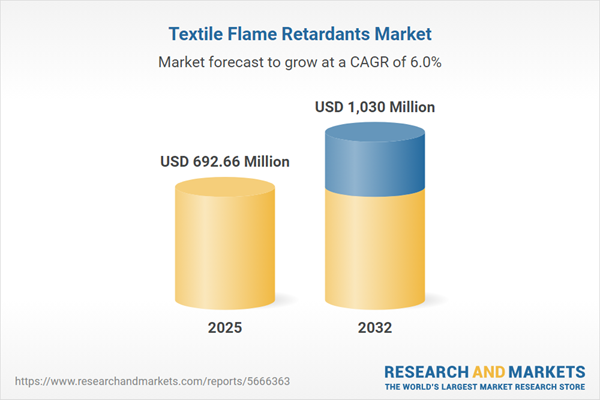Speak directly to the analyst to clarify any post sales queries you may have.
Senior decision-makers in the textile flame retardants market must interpret complex regulatory landscapes and sustainability demands while sourcing reliable market intelligence. Rapidly evolving technologies and policy changes require an informed, proactive approach for sustained business advantage and risk management.
Market Snapshot: Textile Flame Retardants Market Overview
The textile flame retardants market is currently valued at USD 653.59 million in 2024, with projections indicating steady growth to USD 692.66 million in 2025 and reaching USD 1.03 billion by 2032. This reflects ongoing demand driven by stricter fire safety standards and broader use of flame-retardant textiles beyond traditional applications. Integration is increasing in industries such as construction, automotive, transportation, and hospitality. Market adaptation is evident through investments in new solution development, strengthening procurement strategies, and enhancing operational agility. Shifting chemical regulations and policy frameworks are further shaping innovation efforts and influencing market-entry decisions across established and emerging regions.
Scope & Segmentation
This report is structured for senior executives seeking actionable insights to advance compliance, competitive benchmarking, and innovation in textile flame retardants. It assesses vital market dimensions along the full product and value chain:
- Type: Analysis includes halogenated, non-halogenated, mineral, nitrogen, phosphorus, silicone-based, and reactive flame retardants, each playing a role in advancing fire safety and supporting sustainability transitions in diverse textile applications.
- End Use: The evaluation spans home textiles, protective apparel, and industrial end-users in automotive, construction, filtration, geotextiles, aerospace, and transportation infrastructure, recognizing distinct technical requirements and regulatory hurdles for each sector.
- Technology: Coverage details industry-preferred production methods such as backcoating, coating, dipping, exhaust, copolymerization, and grafting, highlighting adaptation to compliance mandates or evolving end-market conditions.
- Application: The study considers backcoating, coating, exhaust, and padding, linking each method to impacts on product durability, regulatory adherence, and performance throughout the product lifecycle.
- Fiber Type: Assessment covers cotton, polyester, nylon, wool, and blended fibers, examining their compliance performance and suitability across different markets and applications.
- Regions: Global analysis covers the Americas, Europe, Middle East & Africa, and Asia-Pacific, with particular attention to North America, Western Europe, and leading Asian production hubs for targeted market-entry and growth strategies.
- Key Companies: Profiles of Clariant AG, LANXESS AG, ICL Group Ltd., Emerald Kalama Chemical LLC, Albemarle Corporation, BASF SE, Italmatch Chemicals S.p.A., Omnova Solutions Inc., Evonik Industries AG, and Solvay SA, emphasizing innovation focus, product portfolio breadth, and international presence.
Key Takeaways for Senior Decision-Makers
- Environmental and fire safety mandates greatly influence operational models, supply chain design, and product lifecycle management across the global textile flame retardants sector.
- Innovation through alternative chemistries, including bio-based options and high-performance fibers, supports diversification of product offerings to align with evolving customer and stakeholder needs.
- Continuous, accurate market intelligence enables timely alignment of R&D, supply chain investments, and regulatory compliance efforts with shifting regional and global standards.
- Increased attention to product longevity and regulatory benchmarks supports greater stakeholder confidence and positions companies to exceed rising expectations.
- Localization in production and sourcing facilitates accelerated adaptation to evolving trade environments and enhances alignment with regional compliance requirements.
Tariff Impact: Navigating 2025 U.S. Trade Dynamics
With the introduction and possible expansion of U.S. tariffs, companies are reassessing sourcing and production strategies. Enhanced investment in local manufacturing capabilities and closer collaboration with domestic suppliers are becoming standard responses, ensuring compliance and increasing resilience within supply chains amid policy change.
Methodology & Data Sources
Findings in this report are drawn from direct interviews with manufacturers, chemical formulators, and procurement executives, with expert panel validation. Supplementary secondary research ensures robust accuracy and actionable relevance for executive-level use.
Why This Report Matters: Textile Flame Retardants Market Strategy
- Connects compliance and technology choices directly to dynamic policy and marketplace factors, clarifying both elevated risks and new opportunities for market participants.
- Facilitates precise benchmarking and fosters responsible growth across diverse product lines and regions, improving strategic positioning.
- Equips executive teams with authoritative market intelligence to support expansion, scalability, and alignment with ongoing regulatory shifts and sector momentum.
Conclusion
Access to comprehensive, market-driven insights empowers senior leaders to anticipate industry changes, refine strategies, and support robust, future-ready operations in the evolving textile flame retardants sector.
Additional Product Information:
- Purchase of this report includes 1 year online access with quarterly updates.
- This report can be updated on request. Please contact our Customer Experience team using the Ask a Question widget on our website.
Table of Contents
3. Executive Summary
4. Market Overview
7. Cumulative Impact of Artificial Intelligence 2025
Companies Mentioned
The companies profiled in this Textile Flame Retardants market report include:- Clariant AG
- LANXESS AG
- ICL Group Ltd.
- Emerald Kalama Chemical LLC
- Albemarle Corporation
- BASF SE
- Italmatch Chemicals S.p.A.
- Omnova Solutions Inc.
- Evonik Industries AG
- Solvay SA
Table Information
| Report Attribute | Details |
|---|---|
| No. of Pages | 184 |
| Published | November 2025 |
| Forecast Period | 2025 - 2032 |
| Estimated Market Value ( USD | $ 692.66 Million |
| Forecasted Market Value ( USD | $ 1030 Million |
| Compound Annual Growth Rate | 5.9% |
| Regions Covered | Global |
| No. of Companies Mentioned | 11 |









